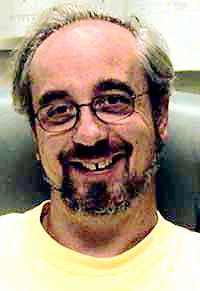By Ernie Tretkoff
 Con Beausang |
Two nuclear physicists have been sharing their expertise by organizing and teaching classes on radiation detection and safety for first responders and other community members.
Con Beausang, a nuclear physicist at Yale University, along with members of his lab, started teaching courses on the basics of radiation for first responders in 2002. Though the classes are not about terrorism per se, said Beausang, the 9/11 attacks inspired him to reach out to the community.
"The classes are entirely free," said Beausang. "We receive no funding from anyone. All of the people who help to teach and prepare the classes, from professors to graduate students, volunteer their time."In the classes, which consist of four weekly three-hour sessions, first responders learn "a little about health effects of radiation, how detectors work, what they can find, and what they can't," explained Beausang.
"We're not trying to teach physics. That's not what they want," said Beausang. "They have radiation detectors, and we're trying to demystify the process of radiation."
More than 40 first responders, including police, FBI, and Coast Guard, have taken the course, which Beausang has offered three times so far. Beausang plans to offer his course again in February.
While many first responders had already received some training dealing with radiation, the amount of the knowledge they had varied. US Coast Guard officer Mike Edgerton said he attended Beausang's course with his unit "to become more knowledgeable regarding the behavior and property of radiation, in order to improve our ability to respond to potential contingencies involving radiation, and to learn about the effects of shielding and other barriers in detecting radiation sources." Edgerton said his unit found the course very helpful. "I believe that we significantly improved our understanding of radiation," he said.
Lee Schroeder, a nuclear physicist at Lawrence Berkeley National Laboratory, has organized a similar course, covering the basics of radiation and offering some hands-on experience.
He started thinking about offering the course in the summer of 2002, when the Department of Energy, the National Science Foundation, and the APS Division of Nuclear Physics (DNP) put a workshop together in Washington on the role of the nuclear physics research community in combating terrorism.
The workshop led to several broad recommendations, one of which was that the nuclear physics community should explore ways of better communicating knowledge of nuclear physics to all interested groups. "The thing that really came out is a sense in the community that one of the things we have to offer is educational outreach," said Schroeder. He decided to get in touch with the Berkeley city council to organize the radiation course.
Several LBNL researchers and staff members, including life scientists and environmental health and safety experts, contributed by teaching a segment of the course. Between 70 and 80 first responders, mainly firefighters and HAZMAT workers, attended the classes. These first responders became more familiar with their instruments and learned what to do when they find radiation or believe that an area is contaminated.
"Although first responders have had information like this, having the opportunity to talk to nuclear scientists on those subjects has been useful," said Schroeder.
The course started in November, and included a total of 12 sessions lasting 2.5 hours each. Now Schroeder is seeking feedback and considering how to modify the course for the future. "We expect this to be going forward," he said.
Both Beausang and Schroeder believe other physicists may be reaching out to their communities in similar ways, but at the moment no organized structure exists for physicists who want to teach these kinds of courses.
The DNP has planned a joint session with the Physics and Society Forum for the April meeting in Denver. Schroeder said the session would include discussion of outreach efforts like the classes Beausang and Schroeder have organized.
Neither Beausang nor Schroeder receive any funding for their courses, though LBNL encourages outreach and offered some release time to scientists and staff members who helped prepare and teach the course. Schroeder also said he would look into getting funding from the Department of Homeland Security or other sources.
Schroeder envisions running the course in Berkeley for first responders about once a year, or maybe offering it to a larger base of community members.
"It's pretty clear that the lack of knowledge regarding the nature of radiation is fairly large, and a lot of people are both concerned and frightened," he said.
©1995 - 2024, AMERICAN PHYSICAL SOCIETY
APS encourages the redistribution of the materials included in this newspaper provided that attribution to the source is noted and the materials are not truncated or changed.
Associate Editor: Jennifer Ouellette
March 2004 (Volume 13, Number 3)
Articles in this Issue

